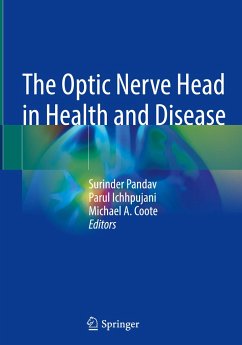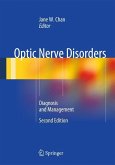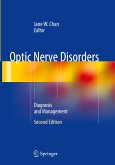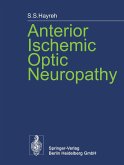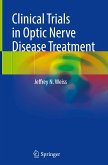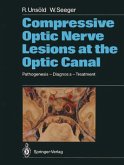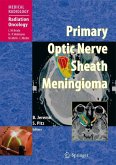The Optic Nerve Head in Health and Disease
Herausgegeben:Pandav, Surinder; Ichhpujani, Parul; Coote, Michael A.
The Optic Nerve Head in Health and Disease
Herausgegeben:Pandav, Surinder; Ichhpujani, Parul; Coote, Michael A.
- Gebundenes Buch
- Merkliste
- Auf die Merkliste
- Bewerten Bewerten
- Teilen
- Produkt teilen
- Produkterinnerung
- Produkterinnerung
The book provides a detailed description in color format of the optic nerve head changes that occur in glaucoma. It explains the normal and variant anatomy of an optic nerve head and why certain discs are more or less likely to develop glaucomatous changes.
This book attempts to explain the anatomical basis of common and not so common signs seen in optic nerve head and retinal nerve fibre layer as captured by a digital fundus imaging system and optical coherence tomography. It also includes optic nerve head conditions mimicking glaucoma.
The book is relevant for practicing…mehr
Andere Kunden interessierten sich auch für
![The Optic Nerve Head in Health and Disease The Optic Nerve Head in Health and Disease]() The Optic Nerve Head in Health and Disease90,99 €
The Optic Nerve Head in Health and Disease90,99 €![Optic Nerve Disorders Optic Nerve Disorders]() Optic Nerve Disorders75,99 €
Optic Nerve Disorders75,99 €![Optic Nerve Disorders Optic Nerve Disorders]() Optic Nerve Disorders90,99 €
Optic Nerve Disorders90,99 €![Anterior Ischemic Optic Neuropathy Anterior Ischemic Optic Neuropathy]() Sohan S. HayrehAnterior Ischemic Optic Neuropathy39,99 €
Sohan S. HayrehAnterior Ischemic Optic Neuropathy39,99 €![Clinical Trials in Optic Nerve Disease Treatment Clinical Trials in Optic Nerve Disease Treatment]() Jeffrey N. WeissClinical Trials in Optic Nerve Disease Treatment119,99 €
Jeffrey N. WeissClinical Trials in Optic Nerve Disease Treatment119,99 €![Compressive Optic Nerve Lesions at the Optic Canal Compressive Optic Nerve Lesions at the Optic Canal]() Renate UnsöldCompressive Optic Nerve Lesions at the Optic Canal77,99 €
Renate UnsöldCompressive Optic Nerve Lesions at the Optic Canal77,99 €![Primary Optic Nerve Sheath Meningioma Primary Optic Nerve Sheath Meningioma]() Primary Optic Nerve Sheath Meningioma38,99 €
Primary Optic Nerve Sheath Meningioma38,99 €-
-
-
The book provides a detailed description in color format of the optic nerve head changes that occur in glaucoma. It explains the normal and variant anatomy of an optic nerve head and why certain discs are more or less likely to develop glaucomatous changes.
This book attempts to explain the anatomical basis of common and not so common signs seen in optic nerve head and retinal nerve fibre layer as captured by a digital fundus imaging system and optical coherence tomography. It also includes optic nerve head conditions mimicking glaucoma.
The book is relevant for practicing ophthalmologists, vision science researchers, clinical optometrists, postgraduate residents in ophthalmology, sub-specialty fellows as well as general ophthalmologists, neurologists and neurosurgeons.
This book attempts to explain the anatomical basis of common and not so common signs seen in optic nerve head and retinal nerve fibre layer as captured by a digital fundus imaging system and optical coherence tomography. It also includes optic nerve head conditions mimicking glaucoma.
The book is relevant for practicing ophthalmologists, vision science researchers, clinical optometrists, postgraduate residents in ophthalmology, sub-specialty fellows as well as general ophthalmologists, neurologists and neurosurgeons.
Produktdetails
- Produktdetails
- Verlag: Springer / Springer Nature Singapore / Springer, Berlin
- Artikelnr. des Verlages: 978-981-33-6837-8
- 1st edition 2021
- Seitenzahl: 176
- Erscheinungstermin: 7. April 2021
- Englisch
- Abmessung: 260mm x 183mm x 15mm
- Gewicht: 580g
- ISBN-13: 9789813368378
- ISBN-10: 9813368373
- Artikelnr.: 60808458
- Herstellerkennzeichnung
- Springer-Verlag GmbH
- Tiergartenstr. 17
- 69121 Heidelberg
- ProductSafety@springernature.com
- Verlag: Springer / Springer Nature Singapore / Springer, Berlin
- Artikelnr. des Verlages: 978-981-33-6837-8
- 1st edition 2021
- Seitenzahl: 176
- Erscheinungstermin: 7. April 2021
- Englisch
- Abmessung: 260mm x 183mm x 15mm
- Gewicht: 580g
- ISBN-13: 9789813368378
- ISBN-10: 9813368373
- Artikelnr.: 60808458
- Herstellerkennzeichnung
- Springer-Verlag GmbH
- Tiergartenstr. 17
- 69121 Heidelberg
- ProductSafety@springernature.com
Dr.Surinder Pandav is Professor and Head of the department of ophthalmology at the Advanced Eye Centre, Postgraduate Institute of Medical Education & Research, Chandigarh, India. His main role is to organize Glaucoma services including patient care, medical education and research at his institute. Dr. Pandav did his glaucoma fellowship at Royal Perth Hospital and Center for Ophthalmology and Vision Sciences, Lions Eye Institute, University of Western Australia in the years 2004-2006. Dr. Pandav served as visiting professor at the Center for Eye Research Australia, University of Melbourne, Australia, in 2014-1016, where he coordinated the Glaucomatous Optic Neuropathy Evaluation (GONE) project, which is an internet based system for evaluation of optic disc assessment skills among ophthalmologists and trainees, and conducted research on understanding functioning of glaucoma drainage devices with the aim todevelop newer drainage devices. He is keenly interested in glaucoma surgical research especially mechanisms of wound healing after surgery and effect of aqueous flow through the tissues. Dr.Pandav is an avid researcher having contributed many articles in peer reviewed publications and a number of book chapters. He also serves as a reviewer for a number of ophthalmology journals. Dr.Pandav regularly organizes training workshops for the ophthalmologists of the region and has established a support group to help glaucoma patients. He has conducted a number of glaucoma awareness campaigns to educate public. Dr. Pandav has contributed significantly to a number of professional bodies. Currently he holds the position of the President of the Glaucoma Society of India. Dr. Parul Ichhpujani is currently a Professor at the department of ophthalmology, Government Medical College and Hospital, Chandigarh, India, where she is chiefly responsible for glaucoma and neuro-ophthalmology services. She completed her glaucoma training at theAdvanced Eye Centre, Postgraduate Institute of Medical Education and Research, Chandigarh, India and a subsequent clinical research fellowship, under Dr George L Spaeth, at Wills Eye Institute, Philadelphia, USA. She currently serves on the education committee of the World Glaucoma Association and is the associate managing editor of the Journal of Current Glaucoma Practice, the official journal of the International Society of Glaucoma Surgery. She was ranked among the powerlist 2015 for the "Best 40 ophthalmologists under 40". An avid researcher, Dr Ichhpujani has co-authored three books: Pearls in Glaucoma Therapy, Living with Glaucoma, and Smart Resources in Ophthalmology; and has edited another eight: Expert Techniques in Ophthalmology, Glaucoma: Basic and Clinical Perspectives, Manual of Glaucoma, Clinical Cases in Glaucoma: An Evidence Based Approach, Glaucoma: Intraocular Pressure and Aqueous Dynamics, Current Advances in Ophthalmic Technology, Glaucoma, and Ophthalmic Instruments and Surgical Tools. She is also the Springer series editor for the Current Practices in Ophthalmology series. She has also contributed several research articles and book chapters in national and international books and serves as a reviewer for many ophthalmology journals. Dr Michael A. Coote is an Associate professor and senior glaucoma consultant at the Royal Victorian Eye and Ear Hospital Melbourne and was the previous Clinical Director of ophthalmology. He is also a board director of St Vincent's Health Australia and chairs the board sub-committee in research and education and is currently on the executive team of the International Society for Glaucoma Surgery. Dr Michael is an active glaucoma surgery researcher and has developed the CERA model of bleb porosity testing and has published over 50 peer reviewed manuscripts, authored 8 book chapters and has given over 50 international lectures. He is the developer of the Glaucomatous Optic Neuropathy Evaluation (GONE) project, the largest online evaluation and teaching system for ONH evaluation ever created. He is the co-author of the World Glaucoma Association Teaching module for ONH evaluation. His subspecialty interests include glaucoma management and glaucoma surgery, complex and failed glaucoma surgery, minimally invasive glaucoma surgery, anterior segment repair, cataract and complex cataract surgery.
What is the range of normal variations in the optic nerve head appearance?.- What are the characteristic changes to the optic nerve head in glaucoma and how do they evolve over time?.- How to interpret optic disc in myopes?.- What are the key clinical skills and investigative techniques for disc evaluation?.- How to reduce error in optic nerve head examination?.- What imaging errors occur when evaluating the optic nerve head?.- How to interpret difficult optic discs?.- How to accurately assess the severity in people with glaucoma or at risk for developing glaucoma.- What optic nerve head conditions mimic glaucoma?.- Getting better - Learning, new tools and risk management.
What is the range of normal variations in the optic nerve head appearance?.- What are the characteristic changes to the optic nerve head in glaucoma and how do they evolve over time?.- How to interpret optic disc in myopes?.- What are the key clinical skills and investigative techniques for disc evaluation?.- How to reduce error in optic nerve head examination?.- What imaging errors occur when evaluating the optic nerve head?.- How to interpret difficult optic discs?.- How to accurately assess the severity in people with glaucoma or at risk for developing glaucoma.- What optic nerve head conditions mimic glaucoma?.- Getting better - Learning, new tools and risk management.

